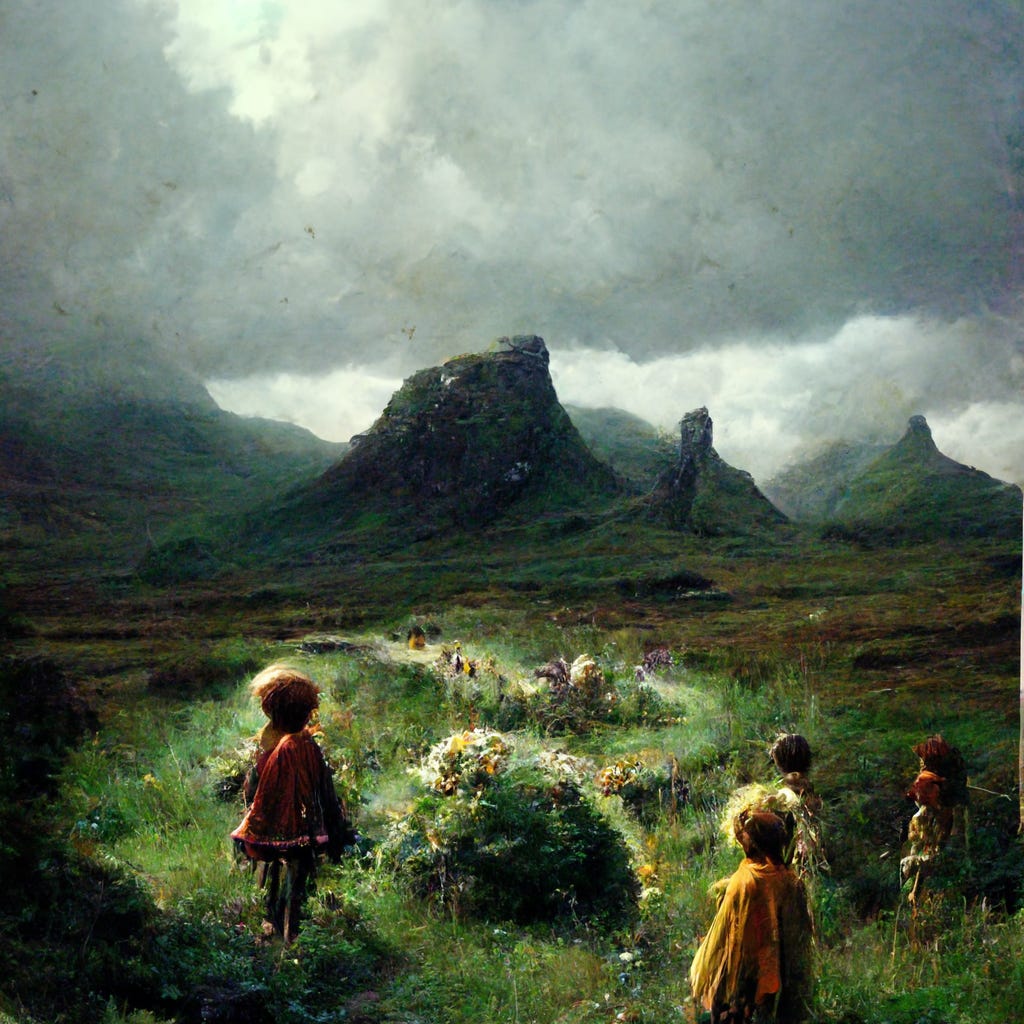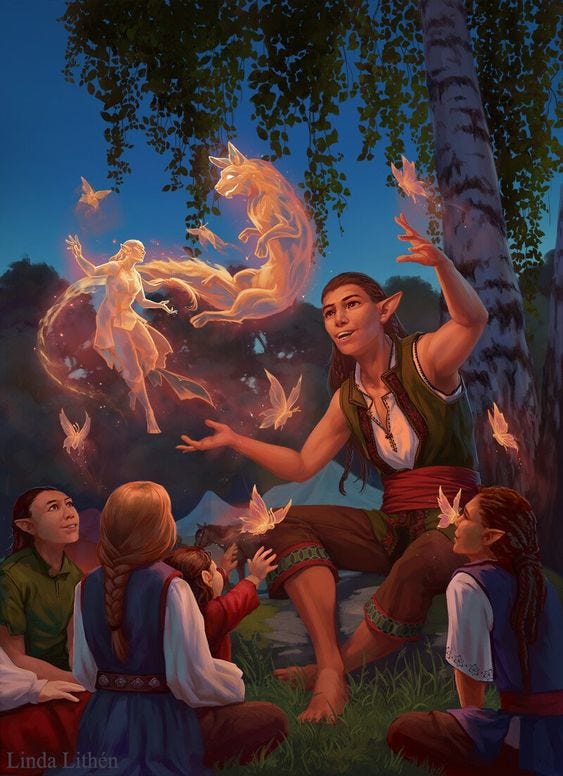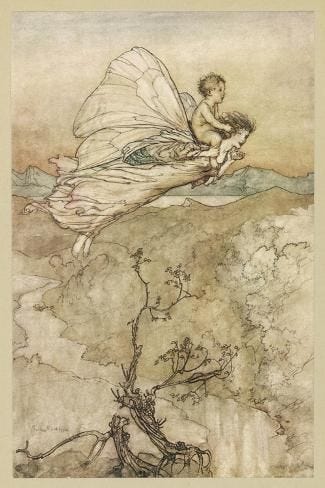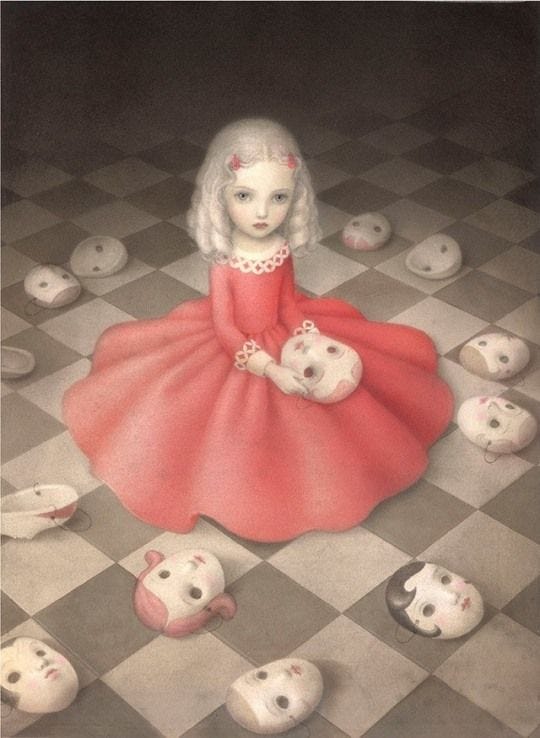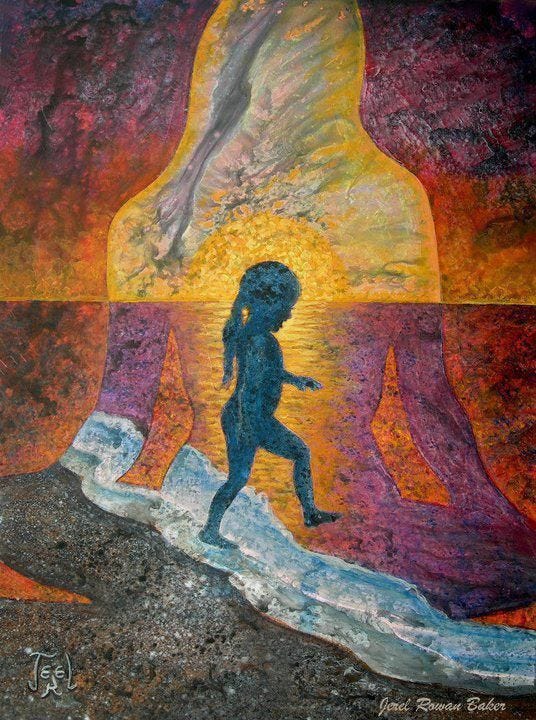Berkana - Come away, O human child!
Today’s pickings Come away, O human child!Dangerous Psychology of Folklores and its Prevalence in the Modern World
As the light fades from my window and the slow-burning incense smoke prowl about the air like an invisible master keeping the atmosphere inside in check. I sat down to write about a time distinct from ours, a past deep buried in the layers of time that have passed between eons, with humans evolving from stonemasons to AI-wielding Gods. A time during which lightening up the hearth was the only way to help the family get through the dark resentful winters. I pondered on the fear and anger people felt when they encountered unexplained phenomena in a relatively unexplored world. The lack of ability to reason and rationalize is difficult to live with, especially when survival is challenged. It must have become inevitable to create fiction based on self-interest instead of finding out the truth. In that way, it is easier to make decisions, and many would choose easy over right. This behavior is not uncommon in modern times too, especially if it concerns a phenomenon that is currently unexplored or not understood. During such time we make lores, to protect us psychologically, like a warm blanket of familiarity during life-altering situations. We dissociate from the experience, abandon our better selves, and create a fantasy to rely on. We abandon ourselves to assume roles and act in a way we would have never acted if not motivated by fear, anger, or grief. Society pushes us to take such action, lauds us for them, asks us to err, to surrender to the fictionland of our still evolving minds, and when we allow ourselves such leisure, the same society penalizes us. For most of the world's superstitions, I only blame the power mongers, proto-capitalists, religious zealots, and sociopathic upper class of the medieval world. With skewed class dynamics, where anyone below the ruling class is allowed to believe in any dangerous superstition as long as the symbols of power and authority are not challenged. Logic was seldom employed, rarely instilled among the commoners. The sea between the lush fertility of knowledge and power of the noble classes, and the depravity from such treasure among the lower classes were too great to cross. To simply put, one who lived in darkness all their lives when confronted by light, will either turn blind or be enlightened. However, this illumination was hard to come by for the prisoners of faith. The people turned to faith when the world seemed a cold and cruel place to be contended and won against to stay alive. When people surrendered themselves in laps of faith, they dreamed of magic and miracles, they envisioned an alternate future, a lucrative one, where they are not starving or cold, not diseased or dying, and where they are free from the consequences of their birth. From the depth of such wayward imaginations, millions of folklores, fairytales, and urban legends were born. Today I will take you down the dark yet fascinating alleys of folklores across Europe. Folklores are myriad, there are at least as many as there are cultures, nations, civilizations, and religions in the world. Folklores are mosaics of infinite curiosities and traditions, blending to create millions of culturally relevant stories. There are a few, which are traceable and others whose origins are lost to the wheel of time. Since folklores are fragments of the past, they entwine within them the essence of a memory that faded into oblivion. As a folklore enthusiast, I am painfully aware that some of those memories are bewildering while others are downright terrifying. Out of the shadows peeks a medieval world that is primitive and rightfully forgotten. Those shadows need to be brought into light for a simple reason, to examine the problems of our modern world while sticking one foot in the lessons learned through history. The recurring leitmotif in most folklores is often indicative of underlying complexities of the time of which the lore is a product. The problems of those times might not exist today, but it gives us a perspective to look at today's problems from new angles. It frees us from our prejudices and preconceived notions about the world around us and pulls our focus into certain realizations. One of which is that we still do not fully comprehend the mysterious workings of the human mind and its various manifestations. Nothing humbles me more than folklores that show the overpowering effect of our lack of understanding of our immediate world and our arrogance to act with such ignorance. Weapon of ChoiceFolklores had a purpose, they were created by the collective not exclusively to dispel boredom or as a means of entertainment. Stories have been powerful tools known to human beings since the dawn of civilization. Storytellers are fully aware of this power as they build their stories with immense care and intention. The storyteller deliberately layers the story, its characters, and its many splendid or terrible conclusions depending upon the problem the story addresses. Folklores are never created out of accident, casual deliberation, or reckless passion. These stories are sewn together with well-thought-out agendas. In that sense, the storyteller is always aware of the impact that the story would have on the audience. However, the responsibility for its consequences does not lie with the patron of the story. When it comes down to folklore, the oral tradition prevails, and hence the storyteller is not an individual but an archetype within the collective. A symbolic role assumed by many at any point in time. Today, I am assuming this role and going to retell this folklore but with a focus on analyzing the deeper social, economical, and psychological circumstances of medieval times. We will also focus on the consequences that these terrible circumstances can induce. Purpose of LoresIn her book Women who Run with the Wolves, Clarissa Pinkola Estes invokes the memory of the Wild Woman Archetype through different tropes of this archetype used across various folklores across many western cultures. One such story is that of La Loba, the lore of the wolf woman from the mountains of Northern Mexico. La Loba is the perfect representation of the wild woman. She roams around the mountain trails to collect the bones of the dead animals, especially wolves, assemble them in the shape of their carcass, and then sings a song that brings the creature to life, piece by piece. This sheer determination to preserve what is at the edge of extinction is seen as both a fascinating and dangerous endeavor. Fascinating, because the passion to strive for something selflessly is rare. And dangerous, because such passion can challenge the order of nature. What is dead is supposed to remain dead, but the wild woman with her fervor to create new life defies the laws of nature. This rebellious wildness of her spirit earned her many distinct names in the lore of Eastern Europe. Some refer to her in veneration, some in fear, and others in plain loathing. This polarising admiration and fear have earned her many names among which are La Huesera, Bone Woman; La Trapera, The Gatherer; and La Loba, Wolf Woman. It is incredible how Estes without imposing her definition of the wild woman archetype, suggests that the underlying problem of the women who fit the shoes of this particular archetype is being seen by society as someone who is both magical and dangerous. This psychological response reveals the repressed fears that people inherently possess of the wild woman. Similarly, there are many such archetypes and lores that are used repeatedly to bring out some kind of repressed social or psychological fear of the time. Another such legend that we will uncover today is the North European version of the wild child of the Fairy Folk or the myth of Changelings. Legend Has ItThe fairy lore is extremely detailed and varied depending on whether you are in Scotland, Ireland, Iceland, or Scandinavia. But one common bogeyman of these fairy lores is the Changeling. Perhaps no work of art explained the enticement of the fairy realm as that of Yeats's poem The Stolen Child
A typical changeling tale is akin to this story from north Wales that I am about to narrate: In the mountains of Wales, there lived a farmer with his wife and infant son. One day while the farmer left for work, his wife got an urgent note saying that a village elder needed tending to and so she left in a haste, leaving behind the sleeping baby in his cradle. On her way back to the cottage at dusk, she grew uneasy remembering that the fairies often cross the hills to look for human babies. However, on reaching home she found that the cradle was undisturbed, and the babe is still fast asleep. Days went by, and the once plump baby grew sickly and pale, wailing in his crib for hours on end. The tormented infant drove the desperate parents to an uneasy conclusion that this is not their baby. The only explanation could be that the faeries who live beneath the hills have stolen their jolly child and replaced it with this dreary-looking changeling who does not grow older or healthy despite devouring all of their rations. The Farmer was insistent on placing the child naked on an iron shovel and placing her on the hillside in midst of freezing winter, but his wife would not let anyone harm the child which she so desperately believed was hers. When all the household supplies were exhausted, the wrinkled-looking baby with its shrunken limbs cried for more food. Now that things were going out of control, the distraught mother ran out to seek the advice of the village elder. “Listen carefully and do exactly as I tell you to find out if the child is yours or that of the fairy folk”, the old woman said. The farmer’s wife now filled with fresh wisdom and determination, went home. In front of the baby’s crib, she broke two eggs, emptied the shells and filled it with wine, and started boiling them over the fire. The creature in the cradle started to laugh and spoke aloud in a deep voice, “I am as old as the moors, but never in my life have I ever seen before someone boiling wine in eggshells”. The farmer’s wife was now assured that this was not her child but a trickster fairy who entered her house to rob them of food, comfort, and happiness. She instantly picked up the creature and threw it in the hearth as the old woman advised. To her great delight the creature’s haggard body went up in smoke, and amongst the ashes, she found her beautiful boy gleefully waving his arm. Hanging on by Toxic HopeIt is essential to mention here that these stories even though very carefully crafted with a desirable fantastical ending, are anything but fantasy. These folktales are consciously categorized by the Grimm brothers as urban legends instead of fairy tales. Even if the structural layout confronts the reader with a story set in a time unlike ours, some details like geographies and the presence of a patron point to a time more historical than fantastical. The ‘Once upon a time' aspect of the story is intentionally omitted. Almost all of these stories end with a fantastical event of the human child being returned to its rightful parents. But this occurs only after the changeling is either tortured, abandoned, starved, or murdered conspicuously. If you observe closely, the whole plot of the story even justifies the cruelty towards the sickly child, generally assuming that the infant was not human at all. The validation of this brutality often comes from the conclusion that the original baby would be returned by the fairy if they threatened the changeling. These fantastical endings are cruel because their delusional ends ingrained a toxic hope within the parents of the infants who probably needed medical care. The superstitious peasants hoped that maybe there is a magic that will eventually return the child who was not sick or a burden on them. Their desperate measure indicates how economically draining it was for a common household to raise a physically or mentally disabled child. Maladies of the TimeThe reality of changelings folklore is the furthest thing from these medieval superstitions. If we analyze all the behavior considered to be problematic for the parents, pushing them to believe that their child is not their own, we will see a pattern emerge. Here are a few common characteristics of this trope: 1. The child is a newborn or an infant, usually a boy 2. It cries endlessly in an almost inhuman manner 3. It is always hungry or wanting to be fed 4. It looks frail or in some cases older but never grows in size 5. It is dependent on a carer and drains parents financially 6. The mother feels disconnected from her child Modern common sense indicates that these characteristics are signs of physical or mental ailment the child is suffering. The most pragmatic solution would be to take the child to a doctor, but these were medieval times we are talking about. These were dark times before the age of enlightenment, long before rational and scientific thinking took the world by storm. In these dark recesses of the psyche, people were adamant about the unexplainable and tied it with the superstition of Gods and demons, fairies and witches, instead of looking deep into the deficiencies of their circumstances. Some of those aforementioned characteristics are also indicative of children suffering from cystic fibrosis, cerebral palsy, spina bifida, or down syndrome, which were unexplainable in the dark age. Most of these unfortunate children met their fated tragedy of being murdered by parents who were acting out of irrational fear provoked by real circumstances of deprivation. And as far as maternal disconnection is concerned, it is a sign of postpartum depression. These stories underline the fact that the mother almost always in these stories inherently feels that the child is not their own. This kind of disconnection is usual when one newly steps into motherhood. The stress of constantly tending to the child, needing to feed, bathe and monitor them restlessly causes immense mood swings and dissociation with the child in the early stages of motherhood and is completely normal. I have heard my mother joke many times that I was such a fussy baby when it comes to eating and bedtime, that she often thought that I was swapped with her original child, which she secretly wished was someone who did not wake them up at midnight. This implies that the idea of a perfect baby is a bigger myth than changeling itself. The decision to harm your flesh and blood is a twisted and demonized psychological behavior. For people with conscience, to even try to test these methods of torture needed the approval and support of their immediate community. For the delusional parents, such decisions were not morally possible to take without the role of village elders, or patriarchs like noblemen or clergymen. So most often than not the lore will include the remark of an advisor or a guide who insists the parents to commit these horrible crimes, often promising impunity and safe return of their child. However, the reality is often more horrifying than lores. One such recorded case in history is the murder of Bridget Cleary. On a fated day in 1895, Bridget was reported missing by her friends and neighbors. Bridget was married to Michael Cleary and was living in her parental home in the town of Ballyvadlea, Ireland. In her final days, Bridget was suffering from what was diagnosed as severe bronchitis. After the doctor declared the severity as life-threatening, Michael’s desperation turned into delusion. The house of Bridget’s parents was built on, what was believed to be a fairy ringfort. Michael’s delusion got the better of him, and he decided to call a priest to exorcise his wife, who he was convinced, was a changeling. Eerily, Michael’s theory convinced Bridget’s dad and the rest of the family that the sick woman was not the real Bridget but a fairy whose people kidnapped Bridget. The last few days of Bridget Cleary’s life were plagued with torture, abuse, and exposure to pain and confusion. To cast the fairy out, she was beaten and then bathed in urine. When she refused to confess, she was thrown alive into the kitchen oven. Bridget Cleary succumbed to her injury inflicted by the people who could not accept the simple fact that she was a sick girl who needed treatment. When the investigation started, the shocking revelation made it one of the most extreme cases of crime based on superstitions. Cleary was a victim of a patriarchal world, prevalent with a lack of education, and violence towards women in both the domestic and public realm. Keep your Blindfolds onThe changeling folklore carefully juxtaposes the desperation of the young parents living in the Middle Ages, where resources were few and knowledge was scanty, to the fantastical world of fairies who seem abundant, manipulative, greedy, and self-centered. This trope is not coincidental and in fact, has its roots hidden in the social anxiety of the lower economic classes. The idea that one section of the society turns the hamster wheel while the other reaps reward, unequivocally echos through these stories. The trope of a poor mother, announcing her terrible dilemma to a patron who is usually a nobleman or clergyman reoccurs in these stories. It is indicative that ever since then, the rich and powerful merely misguided the simpletons who could not reason. The macabre that followed was simply a response to such thoughtless instigation. Gender biases were hinted at by suggestions of totems like the father’s clothes being kept in the crib to keep away the fairies, or the definitive inclination in the stories to indicate that the child desired by fairies is often a boy. However, gender prejudices were lesser evil in a world infested with lords of the land who encouraged the peasants to incarcerate their babies alive to hide their incompetency to find a cure. Behind the walls of these mysterious lores of forest trolls, fairies, and witches, the rich could shrug off their responsibilities. The politics of the medieval world was the primary reason why such superstitions succeeded and propagated throughout Northern Europe like wildfire. The trope remained unchanged in the modern world too, the only difference is accessibility to information and education has made it difficult for the authorities to shrug their responsibilities further. However, that does not mean abuse has come to an absolute end. Instead, the evil institutions have crafted more complex models to deceive people and benefit from it. Reoccurrence in the Modern worldThe changeling trope might seem like an excuse for child abuse in the old world which is irrelevant in our scientific and rational present, but child abuse based on the superstitious view of the world is still relevant. Under the guise of new age spirituality, modern cults, and impractical religious beliefs, child abuse continues all over the world. From the sexual abuse of minors in the Children of God cult to parents labeling their neurodivergent children as Indigo are a few relevant examples. Many kids with ADHD, autism, dissociative disorder, schizophrenia, and other serious mental disorder are denied support because parents are afraid of the unknown and complex avenues of the human mind. Various forms of mental and physical exploitation of children continue across all social classes, in all countries across the world. Childhood is a vulnerable juncture of an individual’s life, a time where the child learns a lot about their identity and self-worth. Based on what seeds are sown, the child grows either into a magnificent oak or a diseased vine which will be further trimmed and kept away from the abundance of healthier societal produce. The issue we are addressing here is not the manifestation of the problem because the manifestations are merely symptoms of collective anxiety. The problem is rooted in many serious issues like inequality, and lack of opportunities among the lower income strata of the society to break free from the strangle of poverty. This inevitably prevents them from adopting a logical mindset. In this power struggle between the rational and the deceiving, the only standing truth is with those tortured and murdered children whose ghosts scream for revenge and justice across millennia. Although it is too late to bring them to justice, it is never too late to prevent the misuse of power and distortion of the truth (specifically in mainstream media) that can impact the future of our children. The changeling lore stands as a story of a time that screams out for our attention. It tells us to believe in our children and love them even when they are troublesome, incapable, or unamicable. It reminds us, that our children are still our own, even when they are not their best selves, and we should protect them unconditionally because they did not ask to be here, suffering the terrible consequences of our ignorance and folly. If you like my work please take some time to share it with the people you think will love Berkana. Also, please go check Rufat's newsletter That's Philosophical. Rufat writes nuggets of wisdom while exploring various philosophies and their application in the modern world. Rufat's sharp observation and tongue-in-cheek style make his explorations both engaging and relevant. |
Older messages
Pocketful of Hexes
Sunday, August 14, 2022
Juxtaposing the History of Pockets to the History of Veiled Misogyny
Berkana’s Year One Anniversary!
Sunday, June 19, 2022
New Section Announcement and Information on Future Posts!
Wings of Fire - The Forgotten Tradition of Jauhar
Sunday, May 29, 2022
The 12th-century Mass Self-Immolation Practiced by Rajput Women
An Ode to the Heat
Sunday, May 22, 2022
Summertime Nostalgia of Pickles, Folklores, and Profiling of Ghosts
Her Hungry Skin with Star and Moon
Sunday, April 24, 2022
Stories of the Forgotten Armenian Girls Enslaved by the Ottoman Empire
You Might Also Like
3-2-1: The power of limiting your options, the value of eagerness, and what we undervalue
Thursday, November 21, 2024
3 ideas, 2 quotes, and 1 question to consider this week. ͏ ͏ ͏ ͏ ͏ ͏ ͏ ͏ ͏ ͏ ͏ ͏ ͏ ͏ ͏ ͏ ͏ ͏ ͏ ͏ ͏ ͏ ͏ ͏ ͏ ͏ ͏ ͏ ͏ ͏ ͏ ͏ ͏ ͏ ͏ ͏ ͏ ͏ ͏ ͏ ͏ ͏ ͏ ͏ ͏ ͏ ͏ ͏ ͏ ͏ ͏ ͏ ͏ ͏ ͏ ͏ ͏ ͏ ͏ ͏ ͏ ͏ ͏ ͏ ͏ ͏ ͏ ͏ ͏ ͏ ͏ ͏
🤯 You Will Be Left Behind (Unless You Learn These 10 Truths)
Thursday, November 21, 2024
PLUS: Live event. Big lessons. Huge prizes (for everyone) 10 Hard Truths You'll Need to Build Wealth Contrarians, Last week, we teased you with the biggest ownership event of the decade — the Main
Ahrefs’ Digest #210: Google manual actions, fake AI profiles, and more
Thursday, November 21, 2024
Welcome to a new edition of the Ahrefs' Digest. Here's our meme of the week: — Quick search marketing news ICYMI, Google is rolling out the November 2024 Core Update. Google quietly introduces
Closes Sunday • Black Fri TO CyberMon Book Promos for Authors
Thursday, November 21, 2024
Book Your Spot Now to Get Seen During the Busiest Shopping Season of the Year! Please enable images to see this email. Black Friday & Cyber
What Motivates Marketers? The Answers Will Shock You 🫢
Thursday, November 21, 2024
We surveyed marketers across the globe - here's what they say. ͏ ͏ ͏ ͏ ͏ ͏ ͏ ͏ ͏ ͏ ͏ ͏ ͏ ͏ ͏ ͏ ͏ ͏ ͏ ͏ ͏ ͏ ͏ ͏ ͏ ͏ ͏ ͏ ͏ ͏ ͏ ͏ ͏ ͏ ͏ ͏ ͏ ͏ ͏ ͏ ͏ ͏ ͏ ͏ ͏ ͏ ͏ ͏ ͏ ͏ ͏ ͏ ͏ ͏ ͏ ͏ ͏ ͏ ͏ ͏ ͏ ͏ ͏ ͏ ͏ ͏ ͏
🧙♂️ NEW 8 Sponsorship Opportunities
Thursday, November 21, 2024
Plus secret research on SoFi, Angara Jewelry, and Dyson ͏ ͏ ͏ ͏ ͏ ͏ ͏ ͏ ͏ ͏ ͏ ͏ ͏ ͏ ͏ ͏ ͏ ͏ ͏ ͏ ͏ ͏ ͏ ͏ ͏ ͏ ͏ ͏ ͏ ͏ ͏ ͏ ͏ ͏ ͏ ͏ ͏ ͏ ͏ ͏ ͏ ͏ ͏ ͏ ͏ ͏ ͏ ͏ ͏ ͏ ͏ ͏ ͏ ͏ ͏ ͏ ͏ ͏ ͏ ͏ ͏ ͏ ͏ ͏ ͏ ͏ ͏ ͏ ͏ ͏ ͏ ͏ ͏
Literature Lab vol. 1 - Rebecca Makkai | #122
Thursday, November 21, 2024
Fiction: I Have Some Questions for You by Rebecca Makkai ͏ ͏ ͏ ͏ ͏ ͏ ͏ ͏ ͏ ͏ ͏ ͏ ͏ ͏ ͏ ͏ ͏ ͏ ͏ ͏ ͏ ͏ ͏ ͏ ͏ ͏ ͏ ͏ ͏ ͏ ͏ ͏ ͏ ͏ ͏ ͏ ͏ ͏ ͏ ͏ ͏ ͏ ͏ ͏ ͏ ͏ ͏ ͏ ͏ ͏ ͏ ͏ ͏ ͏ ͏ ͏ ͏ ͏ ͏ ͏ ͏ ͏ ͏ ͏ ͏ ͏ ͏ ͏ ͏ ͏ ͏ ͏
The Farmer Strikes Back
Thursday, November 21, 2024
(by studying law)
Why Leaders Believe the Product Operating Model Succeeds Where Agile Initiatives Failed
Thursday, November 21, 2024
The psychological, organizational, and strategic reasons behind this seeming contradiction ͏ ͏ ͏ ͏ ͏ ͏ ͏ ͏ ͏ ͏ ͏ ͏ ͏ ͏ ͏ ͏ ͏ ͏ ͏ ͏ ͏ ͏ ͏ ͏ ͏ ͏ ͏ ͏ ͏ ͏ ͏ ͏ ͏ ͏ ͏ ͏ ͏ ͏ ͏ ͏ ͏ ͏ ͏ ͏ ͏ ͏ ͏ ͏ ͏ ͏ ͏ ͏ ͏ ͏ ͏
December starts, prepare the 2025 marketing
Thursday, November 21, 2024
We're about a week from December 2024 😮 Did the time fly by for you? I would suggest NOW start planning for how to 2X your 2025. An easy way is to improve the effectiveness of everything in your
